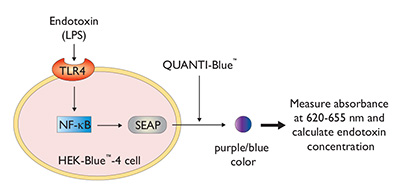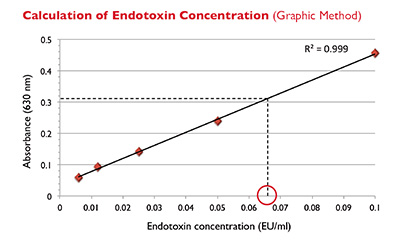HEK-Blue™ LPS Detection Kit 2
| Product | Unit size | Cat. code | Docs. | Qty. | Price | |
|---|---|---|---|---|---|---|
|
HEK-Blue™ LPS Detection Kit 2 Assay for the detection and quantification of biologically active LPS |
Show product |
1 kit |
rep-lps2
|
|
Cell-based colorimetric assay for the detection of biologically active endotoxin
The HEK-Blue™ LPS Detection Kit is based on the ability of TLR4 to recognize structurally different LPS from gram-negative bacteria and in particular lipid A, their toxic moiety. Proprietary cells engineered to become extremely sensitive to LPS, called HEK-Blue™-4 cells, are the main feature of this endotoxin detection kit. The presence of very low concentrations of LPS, starting as low as 0.03 ng/ml, are detected by the HEK-Blue™-4 cells leading to the activation of NF-κB. Using HEK-Blue™ Detection, a specific detection medium, NF-κB activation can be observed with the naked eye or quantified by reading the OD at 650 nm.
The HEK-Blue™ LPS Detection Kit 2 is an assay intended for the detection and quantification of biologically active LPS for research purposes.
It is based on the activation of Toll-like receptor (TLR) 4, the mammalian endotoxin sensor (Beutler B., 2002). TLR4 recognizes structurally different LPS from gram-negative bacteria.
Proprietary cells engineered to become extremely sensitive to LPS, called HEK-Blue™-4 cells, are the main feature of this endotoxin detection kit. These cells stably express human TLR4 and an NF-kB-inducible secreted embryonic alkaline phosphatase (SEAP) reporter gene.
The presence of minute quantities of LPS, starting as low as 0.01 EU/ml, are detected by the HEK-Blue™-4 cells leading to the activation of NF-kB.
Using QUANTI-Blue™, a SEAP detection medium that produces a purple/blue color, NF-kB activation can be observed with the naked eye or measured at 620-655 nm. Since the absorbance is in direct proportion to the amount of endotoxin present, the concentration of endotoxin can be calculated from a standard curve obtained using serial dilutions of the HEK-Blue™ Endotoxin Standard (a preparation of E. coli 055:B5 LPS standardized against FDA approved control standard endotoxin (CSE)).
References:
- Zhang G. and S. Ghosh, 2000. Molecular mechanisms of NF-kappaB activation induced by bacterial lipopolysaccharide through Toll-like receptors. J Endotoxin Res. 6(6): p. 453-7.
- Beutler B., 2003. Science review: key inflammatory and stress pathways in critical illness - the central role of the Toll-like receptors. Crit Care. 7(1): p. 39-46.
- Dobrovolskaia M.A. and S.N. Vogel, 2002. Toll receptors, CD14, and macrophage activation and deactivation by LPS. Microbes Infect. 4(9): p. 903-14.
- Wolk K. et al., 2000.Impaired antigen presentation by human monocytes during endotoxin tolerance. Blood. 96(1): p. 218-23.
- Kariko K. et al., 2004. Small interfering RNAs mediate sequence-independent gene suppression and induce immune activation by signaling through toll-like receptor 3. J Immunol. 172(11):6545-9.
- Darveau RP et al., 2004. Porphyromonas gingivalis lipopolysaccharide contains multiple lipid A species that functionally interact with both toll-like receptors 2 and 4. Infect Immun. 72(9):5041-51.
Specifications
- Simple - Requires basic cell culture knowledge and no specific lab equipment
- Versatile - Measure endotoxin level in virtually all biological reagents
- Highly sensitive - Detect as little as 0.01 EU/ml
- Economical - Up to 500 samples can be tested with the kit
Contents
- 1 vial of HEK-Blue™-4 cells (3-7x 106 cells)
- 8 tubes of 250X HEK-Blue™ Selection (1 ml)
- 4 tubes of 500X Normocin™ (1 ml)
- 1 ml of QB reagent and 1 ml of QB buffer (sufficient to prepare 100 ml of QUANTI-Blue™ Solution, a SEAP detection reagent)
- 2 tubes of HEK-Blue™ Endotoxin Standard (50 EU each)
- 2 bottles of HEK-Blue™ water (60 ml)
Note: Components of the HEK-Blue™ LPS Detection kit can be purchased separately.
![]() The HEK-Blue™ LPS Detection Kit 2 is shipped on dry ice.
The HEK-Blue™ LPS Detection Kit 2 is shipped on dry ice.
![]() Store unopened HEK-Blue™ Selection, Normocin™, and HEK-Blue™ Endotoxin Standard at -20 °C for up to 12 months.
Store unopened HEK-Blue™ Selection, Normocin™, and HEK-Blue™ Endotoxin Standard at -20 °C for up to 12 months.
![]() Store unopened QUANTI-Blue™ and endotoxin-free water at room temperature for up to 6 months.
Store unopened QUANTI-Blue™ and endotoxin-free water at room temperature for up to 6 months.
![]() Resuspended QUANTI-Blue™ is stable for 2 weeks at 4°C and for 2 months at-20°C when properly stored. Avoid repeated freeze-thaw cycles.
Resuspended QUANTI-Blue™ is stable for 2 weeks at 4°C and for 2 months at-20°C when properly stored. Avoid repeated freeze-thaw cycles.
Details
Kit Description

HEK-Blue™-4 Cells
HEK-Blue™-4 cells, the endotoxin sensor cells, are engineered HEK293 cells. These cells stably express TLR4 and multiple genes from the TLR4 pathway.
Additionally, they coexpress an NF-κB-inducible secreted embryonic alkaline phosphatase (SEAP) reporter gene.
HEK-Blue™ Endotoxin Standard
HEK-Blue™ Endotoxin Standard is a preparation of E. coli 055:B5 LPS standardized against FDA approved control standard endotoxin (CSE).
QUANTI-Blue™
QUANTI-Blue™ is a reagent specifically designed for the detection of SEAP. It contains a color substrate that produces a purple/blue color following its hydrolysis by SEAP.
QUANTI-Blue™ is a powdered reagent provided in individually sealed pouches. Each pouch allows the preparation of 100 ml of detection reagent.
HEK-Blue™ Selection & Normocin™
HEK-Blue™ Selection is a solution that combines several selective antibiotics. These antibiotics guarantee the persistent expression of the various transgenes introduced in HEK-Blue™-4 cells. Further, Normocin™ is included in the kit to protect HEK-Blue™-4 cells from any potential microbial contamination, whether caused by mycoplasma, bacteria or fungi.

Principle of the HEK-Blue™ LPS Detection Kit 2
A small volume (20 μl) of the sample or a serial dilution of the HEK-Blue™ Endotoxin Standard is added to the HEK-Blue™-4 cells.
Endotoxins present in the sample or standard are sensed by TLR4 leading to the activation of NF-κB and the production of SEAP in the supernatant. When a small volume (20 μl) of the supernatant is combined with QUANTI-Blue™, which contains a SEAP chromogenic substrate, a purple/blue color appears. SEAP is quantitated by measuring the absorbance at 620-655 nm and extrapolating against a standard curve.
Back to the top



